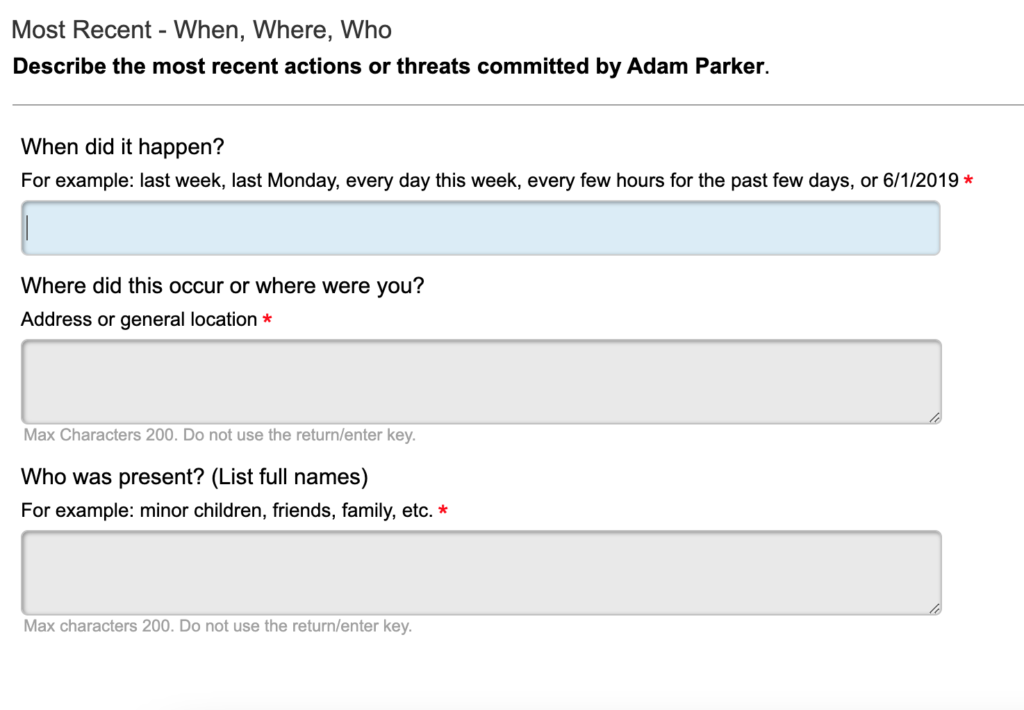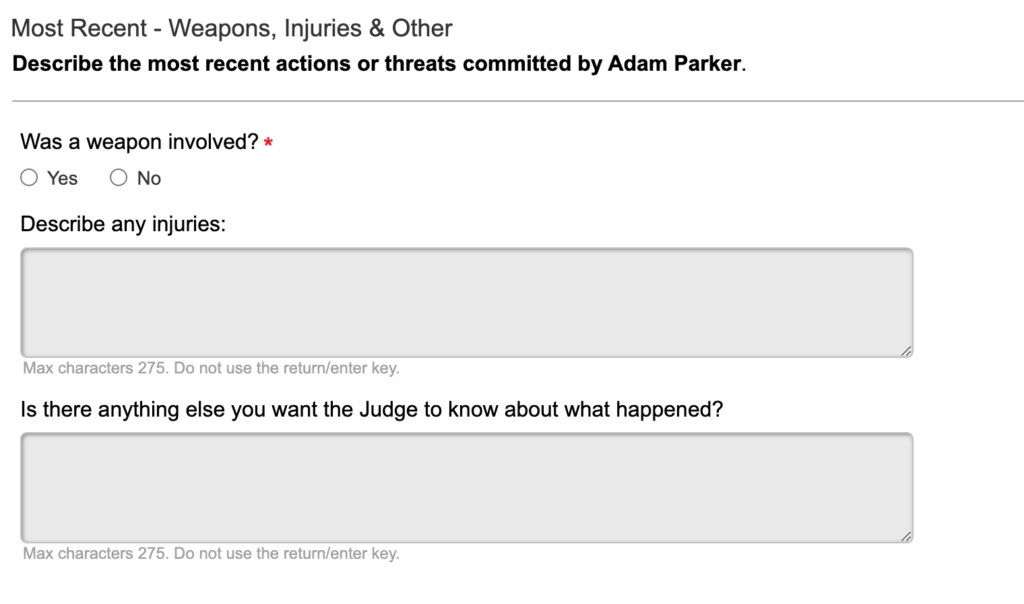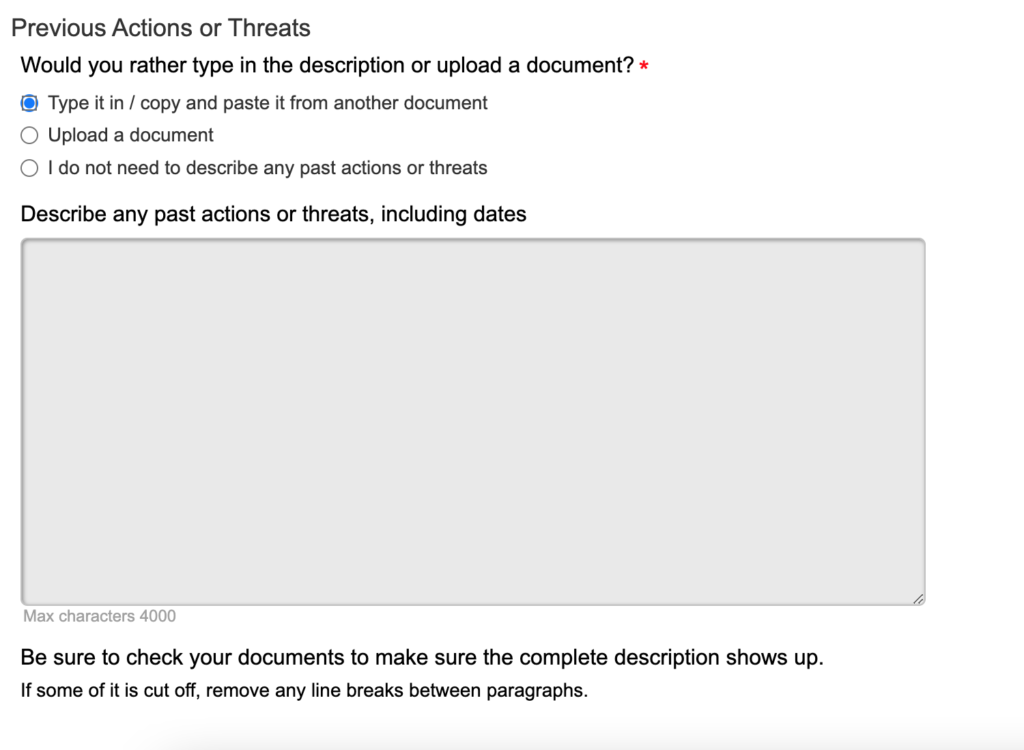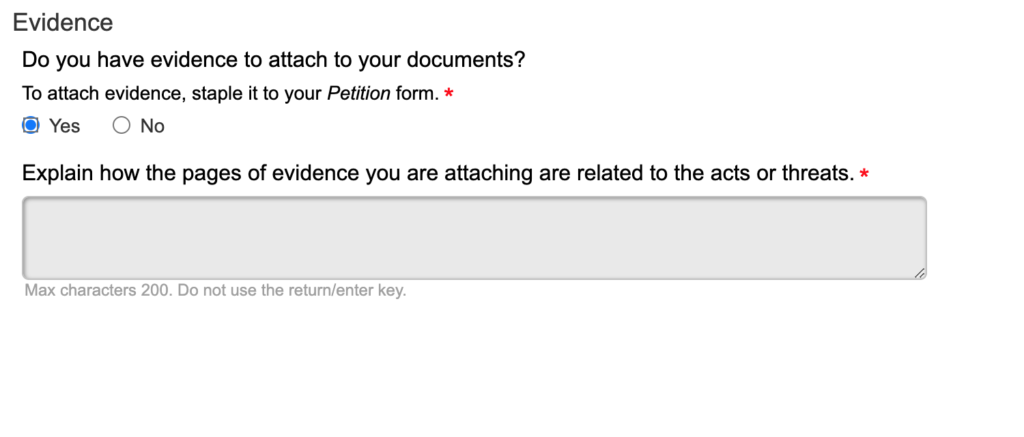How to file a protection order in Idaho
I have filed three protection orders against my ex husband in Idaho, two on behalf of my minor children.
Idaho’s domestic violence statute, as of 2023, define domestic violence as “Physical injury, sexual abuse or forced imprisonment or threat thereof of a family or household member, or of a minor child by a person with whom the minor child has had or is having a dating relationship, or of an adult by a person with whom the adult has had or is having a dating relationship.”
There are also particular provisions that relate to stalking and other forms of harassment, but for this, I am focusing on domestic violence protection orders in Idaho.
Special Notes about the particular fields to fill out:
Does the abuse have to happened in the last 90 days? I have heard advocates and attorneys give conflicting advice over the 90 day requirement. This is a legal question so out of my scope, but I will say that the stalking provisions state explicitly the need for the act to happen within the last 90 days. The domestic violence provision does not.
Since Covid, Idaho has implemented an online filing system that allows you to start, save, and e-file your protection order. The form is not short, so be prepared to take some time to fill it out. You can find the online form here: http://idaho.tylertech.cloud/srl. It does not cost to file a civil protection order. The first 24 “pages” are basic information. You need to list your address, identifying information about your partner, information about children, past crimes, etc. Be prepared that you will be asked if you consider your partner dangerous. I would plan at least a half an hour to fill out that basic information. Create an account so that you can save and return as needed.
When you finally get to the information about the domestic violence itself, you will be asked a series of questions about the incident. It’s important to be thorough but not overwhelm. Items that are often included are: the most recent event, the most serious event, and one other that highlights the seriousness of the situation. Be sure that you stick to the factual recitation of what happened – basically, imagine that you are reading about it in an encyclopedia (who, what, when, where). With my clients, I like to categorize data and group behaviors, including listing the names that they were being called during the episode.
Here is what it will look like when you describe the events:





Be sure to include the evidence that you want the judge to consider at the final restraining order hearing here.
Once you have submitted the form, you will be contacted by the court to schedule a hearing in front of the judge. Your partner will not be informed that you have filed or that you are being seen by the judge. There should be an advocate from the Women’s and Children’s Alliance or Faces of Hope there to help.
The judge will then determine if your case meets the legal standard for a temporary order.
Learn MoreBut What About Male Domestic Violence Victims?
But what about the men?!
Every. Single. Time. I post about women who have experienced compounding trauma by the legal system, whether it’s here or on a news piece, someone will ask BUT WHAT ABOUT THE MEN?!?
First, what about the men?! When I post about women’s experiences in court, nothing about that statement invalidates the male experience. It merely presents the perspective of a protective mother who has experienced gender bias in the court – a bias that has been confirmed by legal research carried out at the GW Family Violence Law Center.
Second, do you know who the biggest perpetrator of male violence is? OTHER MEN. 76% of violence committed against men is a result of men. So even when we talk about male victims, we need to also be talking about male perpetrators.
It’s not that we don’t believe that men experience abuse. It’s not that we don’t believe that women can be perpetrators. I personally have known many personality disordered women in my own life. It’s that this is a gendered problem with gendered consequences. That matters when we are having this conversation.
Here are the statistics:
Males perpetrate 95% of all serious domestic violence. The U.S. Department of Justice estimates that 95% of reported assaults on spouses or ex-spouses are committed by men against women. Eight in ten murderers who killed a family member were male. Males were 83% of spouse murderers and 75% of murderers who killed a boyfriend or girlfriend
Over 85% of the people who commit murder are men, and the majority of women who commit murder usually do so as a defense against men who have been battering them for years. Ninety percent of the women in jail for murder are incarcerated for killing male batterers.
In 88% of the sexual abuse claims that CPS substantiates or finds supporting evidence of, the perpetrator is male.
Of cases where men reported being victims of physical aggression by a female partner, “most of the affected men had been violent toward their partners themselves.”
And yet, even with these known statistics, women have a far harder time convincing the justice system – the family courts in particular- that they (and their children) are the victims. Men do not have the same problem with credibility – as substantiated by Meier’s research.
Inevitability, someone in the comments is going to say that the reason the statistics are so skewed is because men don’t report abuse. Ok. That is absolutely a conversation worth having. But it’s a conversation we should be having on its own, not as a counterpoint to the problem that protective mothers face in court.
I am the mother of two sons – two males who are abuse survivors. I absolutely want to have a conversation about our boys and our men. But I also want to lay responsibility for violence against women squarely at the feet of who is responsible – and that is men.
Additionally, I want our court system to acknowledge its bias against women’s claims of abuse. It is absolutely unhelpful when we want to talk about how women aren’t believed and someone butts in to ask about male victims. That isn’t the topic. That isn’t the problem being discussed. It’s women who are fighting this uphill battle against a system that purports to want to protect children – and that does everything except protect them. THAT is the problem.
Learn More